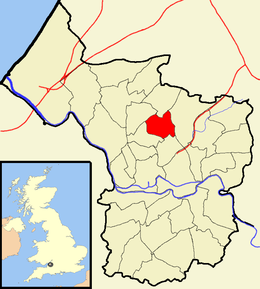Bishopston, Bristol
| Bishopston | |
|---|---|
 Boundaries of the Council Ward, shown within Bristol. |
|
| Population | 13,871 (2011.Ward) |
| OS grid reference | ST586755 |
| Unitary authority | |
| Ceremonial county | |
| Region | |
| Country | England |
| Sovereign state | United Kingdom |
| Post town | Bristol |
| Postcode district | BS7 |
| Dialling code | 0117 |
| Police | Avon and Somerset |
| Fire | Avon |
| Ambulance | South Western |
| EU Parliament | South West England |
| UK Parliament | |
Bishopston is both a council ward of the city of Bristol, England, and a suburb of the city that falls within that ward. Bishopston is around Gloucester Road (A38), the main northern arterial road in the city. The ward includes St Bonaventures and Ashley Down parishes, as well as part of Horfield. It is linked with KV Kuppam in Tamil Nadu, India.
Bishopston is in the Bristol West parliamentary constituency and elects two City Councillors. Its MP is Labour's Thangam Debbonaire and its councillors are Liberal Democrat Dr David Willingham and former Green Party mayoral candidate Daniella Radice
Named after the bishop of the local diocese who controversially sold off the church's land to private developers in the early 19th century. The sale was even raised as an issue in the House of Commons. The parish of Bishopston was then created in July 1862 with a population of 1300 and expanding to 9140 in the Census 1901. In the Census 2001 Bishopston registered a resident population of 11,996. The district is part of the Bristol built-up area, having been swallowed by the growing city, running directly into the surrounding districts of Redland, Ashley Down, Horfield and Henleaze.
The area has a relatively large student population, with 21% of the over 16 population in education compared to 8.4% in Bristol and 5.1% in England and Wales.
The area is known for but now diminishing huge Italian, Irish and South American community who settled there after World War II. Many of the Social clubs, bars and late night drinking dens that could be found on the back streets that served these immigrant communities have now made way for what many believe is unwelcome gentrification of the area with many people being priced out of where they grew up. The area is considered a lot more safer now than what it was in the mid 80s to 90s when the district suffered from gang affiliated crime and had gained a reputation as a place to obtain heroin and more predominantly crack cocaine.
...
Wikipedia
